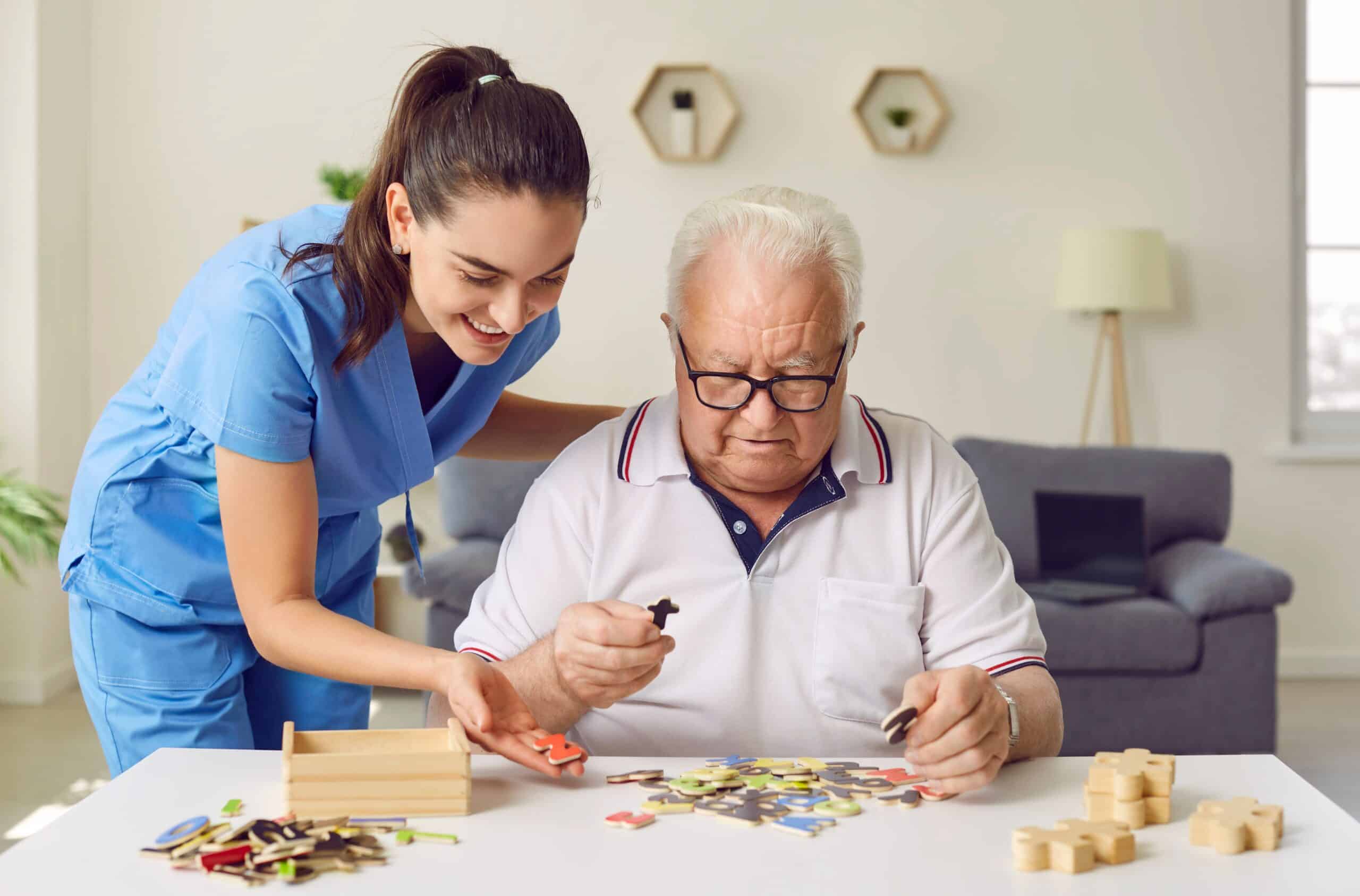
As seniors age, families face critical decisions about care options that will best support their loved ones’ well-being, independence, and quality of life. Two primary options—live-in care and retirement homes—offer distinct approaches, and understanding their differences is essential. While retirement homes provide a communal environment with structured services, live-in care allows seniors to remain in their homes while receiving personalized, round-the-clock support.
This blog explores the numerous benefits of live-in care, highlighting why aging in place can be a superior choice for seniors and their families.
Comparison at a Glance
| Feature | Live-in Care | Retirement Homes |
|
Living Environment |
Familiar home surroundings |
New, communal living environment |
|
Caregiver Attention |
One-on-one personalized care |
Staff shared among multiple residents |
|
Daily Routine |
Flexible, senior-controlled schedule |
Structured, facility-set schedule |
|
Social Interaction |
Personalized companionship, community engagement |
Group activities and communal events |
|
Cost |
Can be cost-effective, especially for couples |
Fixed costs, possible additional fees |
|
Independence |
High level of autonomy |
Some loss of personal freedom |
|
Adaptability of Care |
Care plans evolve with changing needs |
Limited flexibility in care customization |
Understanding the Options
Live-In Care Defined
Live-in care provides a tailored solution where a caregiver resides in the senior’s home, delivering personalized support around the clock. Caregivers assist with essential tasks such as:
-
Personal hygiene
-
Meal preparation
-
Mobility
-
Companionship
The appeal of live-in care lies in its focus on individualized attention. Unlike care settings that require seniors to conform to pre-set schedules, live-in care adapts to the person’s unique needs and preferences.
For example, a caregiver might:
-
Help a senior prepare their favourite breakfast each morning
-
Ensure medication is taken at the right time
-
Accompany them on a walk in the garden
In addition to physical care, live-in caregivers provide emotional support, fostering a relationship based on trust and companionship. This level of connection is especially valuable for seniors who might otherwise feel isolated.
Live-in care is ideal when families need to:
-
Ensure personalized, one-on-one support that adapts to a senior’s unique needs and schedule.
-
Maintain the comfort and familiarity of home while receiving professional care.
-
Preserve a senior’s independence and autonomy by allowing them to set their own daily routine.
-
Provide companionship and emotional well-being through a consistent caregiver relationship.
-
Customize care levels over time, scaling up or down as health needs change.
Retirement Homes Defined
Retirement homes, on the other hand, offer a communal living experience designed for seniors who need some assistance but wish to remain socially active. These facilities typically include:
-
Private or semi-private accommodations
-
Access to communal meals, organized activities
-
Varying levels of medical support
While this environment can be beneficial for those who enjoy group activities and social engagement, it often requires significant adjustments. Seniors must leave their familiar surroundings and adapt to:
-
New routines
-
Shared spaces
-
Interactions with unfamiliar staff and residents.
For individuals who value privacy, independence, or the comfort of their home, this transition can feel overwhelming.
Retirement homes may be a better fit when families need to:
-
Ensure access to structured group activities and a socially engaging community setting.
-
Provide care in a shared setting with on-site medical support available.
-
Accommodate seniors who prefer a structured daily routine rather than a flexible home environment.
-
Simplify daily responsibilities, as meals, housekeeping, and activities are typically provided.
Key Benefits of Staying Home with Live-In Care

Comfort and Familiarity
Home is more than just a physical space—it is a source of emotional security. Remaining in a familiar environment surrounded by cherished memories, personal belongings, and day and night routines can significantly enhance a senior’s quality of life. This is especially true for individuals with cognitive challenges such as dementia, where familiar surroundings help reduce confusion and anxiety.
For example, consider a senior who has spent decades in the same home, developing routines like enjoying coffee in a favourite chair or listening to a specific radio program every evening. These small but meaningful rituals provide a sense of stability that cannot be replicated in a new environment.
By aging in place, seniors also remain connected to their neighbourhood and community, maintaining relationships with nearby friends, neighbours, and local service providers. This continuity can have a profound impact on emotional well-being and overall happiness.
Live-in care provides comfort and familiarity by:
-
Minimizing stress and anxiety by keeping seniors in a familiar and comfortable environment.
-
Preserving daily routines and cherished traditions, fostering a sense of normalcy.
-
Supporting cognitive health, particularly for individuals with dementia or memory challenges.
-
Encouraging community engagement by allowing seniors to stay connected with neighbours, friends, and local organizations.
-
Reducing relocation trauma, preventing the emotional and physical strain of moving to an unfamiliar setting.
Personalized Care

A key distinction between live-in care and retirement homes is the level of personalization. In live-in care, every aspect of support is tailored to the individual’s specific needs and preferences. Caregivers take the time to understand not only the physical requirements of the senior but also their hobbies, routines, and personality.
For instance, a caregiver might prepare meals according to dietary restrictions while incorporating the senior’s favourite recipes, or they may structure the day around activities the senior enjoys, such as gardening or knitting. This kind of one-on-one attention is rarely possible in retirement homes, where staff are responsible for the needs of multiple residents.
The flexibility of live-in care also means that the care plan can evolve as the senior’s needs change. Whether it’s transitioning from occasional assistance to full-time care or addressing new health challenges, live-in care is designed to adapt.
Live-in care ensures personalized attention by:
-
Tailoring care to a senior’s specific medical, emotional, and social needs.
-
Providing flexible care plans that can evolve as health conditions change.
-
Accommodating dietary preferences and restrictions, ensuring meals are enjoyable and nutritious.
-
Allowing seniors to continue their favourite activities and hobbies without institutional limitations.
-
Offering focused, one-on-one attention, ensuring caregivers truly understand the senior’s needs and preferences.
Independence and Autonomy
One of the most significant advantages of live-in care is its ability to preserve a senior’s independence. Unlike retirement homes, where daily schedules are often dictated by communal routines, live-in care allows seniors to maintain control over their lives.
For example, a senior can decide what time they wake up, what they eat, and how they spend their day. They can also continue to pursue hobbies, visit with friends, or enjoy outings to their favourite places with the support of their caregivers. This freedom to make choices fosters a sense of dignity and personal empowerment, which is crucial for emotional well-being.
Live-in care promotes independence and autonomy by:
-
Allowing seniors to make decisions about their daily routines and activities.
-
Providing support without imposing restrictions, enabling them to live life on their own terms.
-
Helping maintain social connections, ensuring seniors continue to see family and friends as they choose.
-
Encouraging engagement in hobbies and personal interests, from gardening to reading to cooking.
-
Keeping couples together, avoiding separation due to different levels of required care.
Cost Comparisons
While live-in care may initially seem more expensive than retirement homes, a closer look often reveals that it can be a more economical option in certain scenarios. For couples, live-in care is particularly cost-effective, as both individuals can receive care in their shared home without incurring separate fees.
Additionally, live-in care eliminates the costs associated with moving into a retirement home, such as relocation expenses, community entrance fees, and the need to furnish a new space. Families can also tailor the level of care to their budget, choosing between full-time or part-time live-in services depending on their loved one’s needs.
Live-in care offers cost-effective solutions by:
-
Avoiding the high costs of moving into a retirement home, including entrance fees and downsizing expenses.
-
Providing care for both partners in a couple, making it a more affordable option than two separate care fees.
-
Offering flexible care plans, allowing families to customize services based on their budget.
-
Reducing unexpected expenses, such as additional fees for specialized care in a retirement facility.
-
Preserving home ownership and assets, allowing families to maintain long-term financial stability.
Challenges in Retirement Homes
Retirement homes provide structure and social opportunities, but they also come with notable challenges that may make them less suitable for certain seniors.
Loss of Personal Space
The transition to a retirement home often involves downsizing and adjusting to shared spaces. Many seniors find it difficult to give up the privacy and comfort of their own home, and communal living can feel restrictive. Sharing dining rooms, recreational spaces, and sometimes even bathrooms may lead to discomfort or a sense of intrusion.
Limited Individual Attention
In retirement homes, staff are responsible for multiple residents, which can result in limited individual attention. This generalized approach may leave some seniors feeling neglected, particularly if they have specific medical or emotional needs that require consistent oversight.
Adjusting to New Environments
Leaving a long-time home for a new, unfamiliar environment can be emotionally challenging for seniors. They may experience feelings of loss, anxiety, or isolation as they adapt to new routines and surroundings. This adjustment is especially difficult for individuals with cognitive impairments, who may struggle to navigate the change.
Additional Advantages of Live-In Care

Caregiver Compatibility
One of the most unique aspects of live-in care is the ability to match caregivers with seniors based on compatibility. Care agencies, like Assurance, prioritize pairing caregivers and seniors who share similar interests, values, and communication styles. This thoughtful approach ensures a positive and harmonious relationship, which is essential for creating a supportive environment.
For example, a caregiver who enjoys gardening can bond with a senior over tending to plants, while one who loves reading can share books and engage in discussions about literature. These shared interests foster meaningful connections that go beyond basic caregiving.
Flexible Care Plans
Unlike the fixed schedules of retirement homes, live-in care offers a level of flexibility that adapts to a senior’s unique and evolving needs. Families can choose the duration and intensity of care, from short-term support after surgery to long-term, full-time care for chronic conditions.
This adaptability ensures that seniors receive the right level of support at every stage, making live-in care a dynamic and sustainable solution.
Socialization at Home
A common misconception is that seniors who age at home may feel isolated. However, live-in care actively supports social engagement. Caregivers provide companionship, facilitate visits with friends and family, and help seniors participate in community activities.
For instance, a caregiver might accompany a senior to their local bridge club or assist them with technology to video chat with distant relatives. These small but meaningful interactions help seniors maintain their social connections and emotional well-being.
Specialized Care for Chronic Conditions
Seniors with chronic health conditions often require specialized care that retirement homes may struggle to provide. Live-in caregivers are trained to manage a range of conditions, from diabetes and arthritis to Parkinson’s disease and dementia.
For example, a caregiver might monitor blood sugar levels, assist with mobility aids, or create a safe environment to prevent falls. This level of personalized support ensures that seniors can age safely and comfortably in their own homes.
Dispelling Myths About Live-In Care
Despite its benefits, misconceptions about live-in care often deter families from considering this option. Let’s address some common myths:
“Live-in care is unaffordable.”
While live-in care may seem costly, it can be more economical than retirement homes, especially for couples or those with specific needs.
“Caregivers lack training.”
Professional caregivers are highly skilled and trained to manage medical, emotional, and practical needs.
“Seniors will feel lonely at home.”
Caregivers provide companionship and support, helping seniors maintain an active social life.
“Live-in care is only for those with severe health issues.”
Many people assume that live-in care is only necessary for individuals with serious medical conditions. In reality, live-in care is for anyone who wants support with daily activities, companionship<, or simply the peace of mind that help is always available. It can be a preventative solution that enhances independence rather than a last resort.
“Families will lose control over their loved one’s care.”
Some worry that bringing in a professional caregiver means losing influence over their loved one’s well-being. However, live-in care fosters a collaborative approach, where families remain actively involved in decision-making and work alongside caregivers to ensure their loved one receives the best possible support.
“Home care isn’t as safe as a retirement home.”
Many believe that seniors are safer in retirement homes due to on-site staff and emergency response systems. However, 24/7 care provides one-on-one supervision, reducing fall risks, ensuring medications are taken correctly, and providing immediate assistance in emergencies—often making it a safer option than institutional settings.
Why Aging in Place Aligns with Seniors’ Wishes
Most seniors express a desire to remain in their own homes as they age. This preference stems from the comfort, independence, and emotional connection that aging in place provides. Home is a source of familiarity and security, and staying there allows seniors to maintain their identity and routines.
For families, supporting a loved one’s wish to age in place can bring peace of mind, knowing that they are helping their loved one live a fulfilling and dignified life.
The Heart of Home
Live-in care offers a compassionate, personalized, and flexible solution for seniors who wish to age in place. By combining practical support with emotional connection, it allows individuals to remain independent and comfortable in their own homes while receiving the care they need.
For families seeking the best care option for their loved ones, live-in care provides unparalleled advantages.
Want to see if live-in care is right for your loved one? Get in touch with our team today.
About The Author
Stephen Bleeker
Stephen Bleeker is dedicated to redefining senior care as the CEO and founder of Assurance Home Care. His passion for enhancing the quality of life for seniors is at the heart of the company’s mission, which focuses on supporting aging in place through compassionate, personalized care. With a diverse background spanning music, lifestyle, and entertainment, Stephen brings a unique blend of creativity and strategic insight to the healthcare industry. His knack for innovation, customer experience, and holistic marketing has consistently led to exceptional outcomes, making him a dynamic leader who’s transforming how care is delivered.
